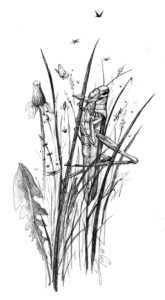By Tim Traver
This spring, we went the no-mow route on about a quarter-acre of our lawn, the last remaining groomed piece we hadn’t turned into vegetable garden or permanent meadow. What a relief! During the hottest, driest spells over the summer, the grass wasn’t growing anyway. The lawn we did mow during the drought – mostly pathways – turned unhappily brown.
Some 50 million acres of the American landscape is covered by lawn, and Americans spend an estimated $100 billion or more each year on lawn care. Yes, there’s beauty in these manicured spaces. But there’s also significant environmental cost in this age of climate four-alarm bells. In recent decades —citing the use of fossil fuels, water use, the damaging runoff of fertilizers, and the detriment of insecticides — many have begun to rethink the mighty lawn.

In his book “Silent Earth, Averting the Insect Apocalypse,” biologist Dave Goulson, notes that though loss of habitats and insecticide use by industrial agriculture are the chief culprits, lawns play a role in the dramatic declines in biodiversity in the insect world, including the loss of pollinating insects. Increasing the biodiversity on our own land has been key to our decision to cut back on the area we mow.
As it grew out, our lawn became a surprising source of beauty: a living canvas. When we were still mowing, it had been a quiet expanse. Now, it was full of noisy grasshoppers and crickets. We noticed an uptick in pollinators, too, with many species of butterflies including fritillaries and swallowtails, as well as hummingbird moths and several new-to-us bee species. The former lawn became busy at night with parties of fireflies hoping to mate. Overhead, for the first time in years, bats hunted the airspace.
Lawns let loose do not immediately become great contributors to biodiversity, but the vegetative beginnings of flowering herbaceous plants and buried seeds lay hidden down there in the turf of our former lawn. These expressed themselves in a sweeping succession of dandelion blooms, a white aster explosion, blue chicory, purple violets nestled deep, the reds and golds of paintbrush, lattice-like bedstraws. The bees loved a widespread miniature mint (Prunella vulgaris), commonly called self-heal or heal-all, as well as the clovers – which are pollinator friendly and nitrogen fixing. The mysterious spikelets (seed heads) of the grasses grew tall. These became a source of delight and wonder.
Giving up lawns does not, of course, mean giving up grasses. These hardy plants, both native and introduced species, occupy a variety of northeastern habitats beyond non-native lawn turf. Grasses are adapted to life in practically every ecosystem on Earth. There are aquatic varieties that live under water and provide nurseries for fish and clams. Highly productive salt marsh grasses buffer pollutants and provide nursery habitat for growing fish. Grasses feed humans and other animals as well: corn, wheat, barley, rye, and sugar cane are some of the more than 10,000 species in the grass family.
We do actually love our mowed spaces and continue to cut borders in our yard. These highlight the unmowed grasses, burnished gold and waving in the breeze. Grasses are flowering plants with leaf and flower parts greatly reduced in size. Pollination is mostly by wind, and so is seed dispersal. Almost all the variation that distinguishes species of grass is found in the various forms of the spikelet structures and flowers so tiny you’ll need a magnifier to identify them. Named or not, grasses will still be here long after we are gone.
With large parts of the United States – and beyond – experiencing drought conditions, and with climate change increasingly at the forefront, could lawn care, like so much else, be on the cusp of wholesale change? Taking a pause from mowing parts or all of the lawn is perhaps the simplest option for lawn owners who want to make a change. Other steps to reduce the impact of lawntending include raising the cutting bar on the mower, leaving clippings on the lawn, eliminating pesticides, and quitting fertilizer or limiting its application to spring and fall when cool season lawn grasses (for example, Kentucky blue grass) are growing.
What will we make of the lawn in the future? Will these spaces grow food? Become forest? Host goats? Provide gardens for pollinators? The opportunities, it seems, are bountiful.
Tim Traver is author of “Fly Fishing and Conservation in Vermont, Stories of the Battenkill and Beyond.” He lives in Taftsville, Vermont. Illustration by Adelaide Murphy Tyrol. The Outside Story is assigned and edited by Northern Woodlands magazine and sponsored by the Wellborn Ecology Fund of the N.H, Charitable Foundation: nhcf.org.




